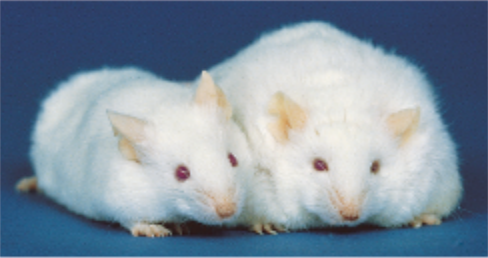Multiple brain areas and signals are involved in the regulation of food intake and the balance between hunger an satiety. One important satiety signal is a hormone called leptin, which is released by fat cells in proportion to how much lipid they contain. Leptin travels through the circulatory system and reaches receptors in a region of the hypothalamus, where leptin activates neurons that inhibit feeding and inhibits neurons that stimulate feeding. Thus, when the body has enough fat, leptin signals the body to stop eating.
In mice, a mutation in the leptin gene, Ob, can lead to obesity. A mouse that is homozygous for the recessive allele (ob/ob) does not produce leptin, and these mice become obese. Another gene (Db) encodes the leptin receptor. A mouse that is homozygous for the recessive allele (db/db) has no leptin receptors, is unresponsive to leptin, and also gets fat.
The functions of these genes were revealed by experiments in which mice of different genotypes were surgically joined so their circulatory systems were interconnected (parabiotic pairing). In this tutorial, experiment with different parabiotic pairings to see the effects of the ob and db mutations on the obesity of mice.
A Parabiotic Pairing

Wild-type mouse
(Ob/- and Db/-)
Genetically obese mouse
(either ob/ob or db/db)
Click on the Next button below to begin.

